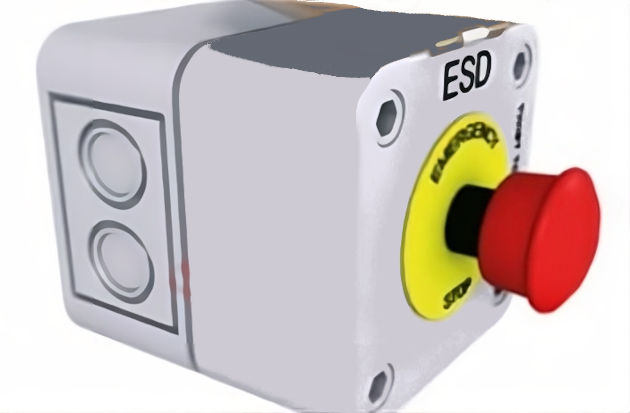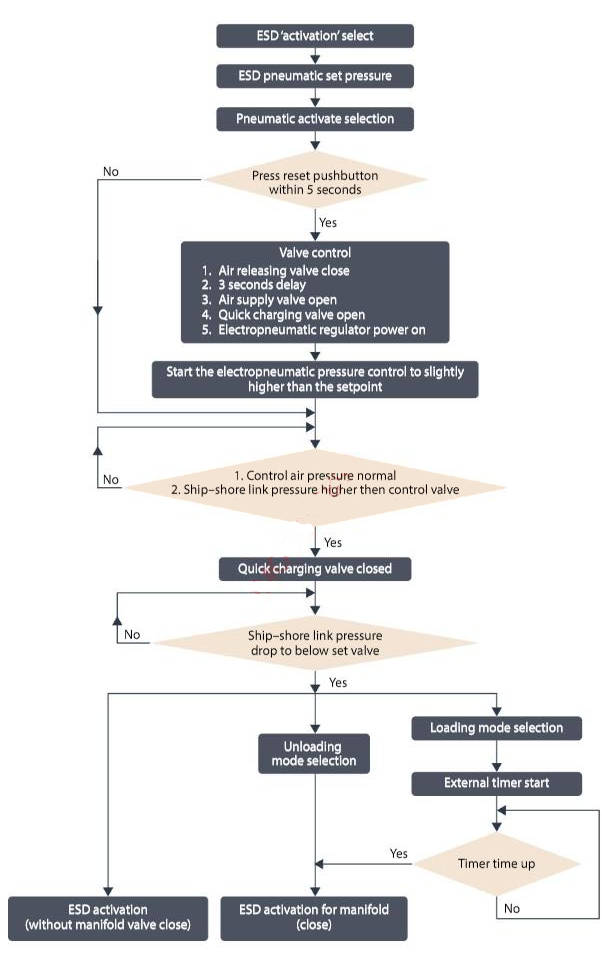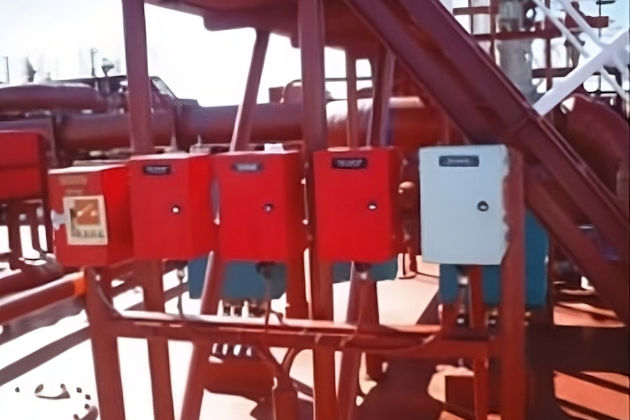Explore the critical role of Emergency Shutdown (ESD) System and Powered Emergency Release Couplings (PERCs) in enhancing safety aboard LNG carriers. Discover effective methods and protocols, including the activation of dry break couplings, ensuring seamless operations and risk mitigation in the LNG industry.
Reference: SIGTTO “LNG Shipping Suggested Competency Standards”, Sections:
1 Have an awareness of the purpose and operating principles:
- emergency shutdown system;
- emergency release system;
- power emergency release couplings (PERCs).
2 Know and understand the principles and methods of operation and methods of communication links between ship and shore and differing requirements for each:
- optical method;
- electrical method;
- wireless method;
- pneumatic method.
3 Know and understand the communication link procedures.
4 Know and understand the operating parameters that will activate ESD:
- emergency shutdown settings;
- emergency release settings.
5 Know and understand the effect of ESD operation:
- effect for ship;
- effect for shore.
6 Know and understand the testing and maintenance procedures:
- conducted on regular basis;
- conducted after connection and prior to conducting cargo operation with shore;
- maintenance requirements and associated testing.
For any serious incident on ship or shore, the cargo operation must be immediately shut down, which may require initiation of the ESDS.

There are two types of emergency shutdown available when a ship is in port, ESD1 and ESD2.
The ship’s ESDS is active at all times, whether at sea or in port. When at sea, all manifold and tank filling valves are held in the shut position and the cargo and spray pumps are held in the off position. The Low Duty Compressor(s) on the Liquefied Natural Gas CarriersLD compressors may be operated as normal, but will stop if an ESD is initiated. The shore ESD input is blocked when the IAS is in the “At Sea” condition.
What is the “ESDS”?
During loading and discharging the Emergency Shutdown System (ESDS) protects the cargo system on board the LNG carrier and the cargo systems ashore. The ESDS provides a link so that a shutdown may be activated from the ship or the shore, either manually or automatically.

ESD1
This is initiated from either the ship or shore and is tested no more than 2 days before arrival and prior to starting cargo operations.
The ESD1 will typically also be activated by:
- blackout of the ship;
- fusible links around each tank dome, manifold and compressor house, which will melt at +98 to +104 °C, which is the spray system water boiling temperature;
- cargo tank full (Very High Level):
- Moss type tank – typically set at 99,47 % Moss;
- Membrane type tank – typically set at 99 % Membrane.
- cargo tank low-low pressure – set at 10 mbar;
- low vapour header pressure (10 mbar);
- hold/cargo tank differential pressure (hold pressure more than cargo tank pressure by 40 mbar);
- low cargo valves hydraulic pressure;
- hydraulic pressure low-low;
- control air pressure low-low;
- when the fire extinguishing system is operated.
Note: When at sea, the very high level (VHL) alarm typically has a 45 s delay in the “AT SEA” mode to prevent spurious alarms and trips occurring due to the ship movement. If it becomes necessary to operate a cargo or spray pump at sea, the signal will need to be overridden.
Effect for ship
Typically, an ESD1 stops the following equipment:
- LD/boil-off gas compressors;
- HD compressor/vapour return;
- cargo pumps in each tank;
- spray pumps and fuel gas pumps.
Closes the following valves:
- manifold valves;
- all cargo tank loading valves;
- spray nozzle valves;
- all remotely operated valves (only manual valves will remain open).
Indicates the following:
- activates the ESD alarm;
- stops gas burning (where applicable).
ESD2
This is operated only by the terminal when alongside and can be activated manually or automatically if the ship moves outside of the movement envelope at the manifold hard arms. The terminal sets the movement envelope limits.
The ESD2 is activated when the ship’s movement on the jetty would risk damaging the hard arms. An ESD2 will automatically close each loading/discharging arm dry-break coupling, which consists of two hydraulically operated ball valves placed in series. In between these valves, a quick release coupling (also hydraulically operated) is installed. If activated, the dry break separates and the outer valve of the loading arm remains on board the ship, connected to the manifold, while the loading arm itself is closed by the remaining valve.
Alarms may also be available on board, via the shore link, if there is any movement outside a set range.
If there is a threat of danger, such as a fire at the terminal that may affect the ship or an out of control fire on the ship that may affect the terminal, the ESD2 is likely to be initiated.
Initiation of the ESD2 system will result in all the actions as for ESD1, but it will also initiate a dry break of the shore arms from the ship. It may also result in activation of the mooring system quick release hooks.
Powered emergency release couplings (PERCs)
The dry break means that the shore arm will be automatically disconnected from the ship. This can be quite violent because the shore arms are connected using PERCs.

On initiation, these valves will close automatically then disconnect, with the elbow part remaining attached to the ship.
It is expected that the terminal will warn the ship prior to initiating ESD2. In any event, personnel should ensure they keep clear of the manifold during cargo operations. In most cases ESD1 will have been activated prior to ESD2 and the alarm acts to warn any personnel round the manifold to leave the area.
Read also: Preparation of loading and unloading operations for LNG/LPG carriers
The addition of dry break couplings at the end of the loading arm considerably increases the weight of the outer arm, so supporting jacks on the ship’s deck are often required.
The ship can be fitted with a number of different connections to link to the various shore ESDSs it will come with. Normally, only one link is used at a time but, if a second link is used, this can be an electric or pneumatic link.
Methods
Optical method. The fibre optic system utilises a multi-channel compatible ship side connector, into which the shore plugs a flexible fibre optic connector that incorporates the ESD, telephone function and mooring tension monitoring system.
Electrical method (Miyaki or Pyle National)
The electric system uses an explosion proof connector with an umbilical cable that is provided by shore or, in some cases, is the ship’s own equipment. The electric system enables ship-to-ship transfer with ESD and hotline telephone connection. The electric system circuits are protected with zener barriers as secondary protection in case the ship breaks away while circuits are still energised.

There may be another electrical system on board, which is the SIGTTO approved connection. This link is designed to the SIGTTO recommendations and is intended to be the international standard for intrinsically safe ESD links. This link covers both Ship/shore interface for safe loading and unloading of LNG/LPG“shore to ship” and “ship to shore” directions.
Wireless method. This provides the same capabilities as either an optical, electrical or pneumatic link, but works on the basis of receivers and transmitters with no physical link.
Pneumatic method. On some LNG carriers, the ESD connection between the ship and shore is achieved using a pneumatic air hose. This is designed so that, in the event of movement of the ship in relation to the jetty, the pneumatic air hose would be damaged and the loss of air pressure would activate the ESD. While this system is still available, it has generally been replaced by transmission of the signal by an optical, electrical or wireless signal.
When an LNG carrier is alongside the jetty, the ship and terminal’s ESDS should be linked with an umbilical. This allows the ship to stop the shore’s pumps in the event of an incident while loading and allows the shore to stop the ship’s pumps in the event of an incident during discharge, so either side can shutdown the other in an emergency. For ships engaged in ship to ship (STS) operations, a pneumatic link is provided.
IGC Code requirements for ESD valves
The IGC Code (18.10) requires remotely operated, emergency shutdown (ESD) valves to close liquid and vapour transfer valves to prevent outflows of liquid and vapour and isolate the ship from the shore in the case of an emergency. This should be automatic in the Fire Scenarios on liquefied gas carriersevent of a fire. They must be of the “fail close” (close on loss of power) type. In addition, they must operate from fully open to fully closed under all service conditions and in the minimum time consistent with the avoidance of excessive pressure surges in the attached piping, both on the ship and in the shore loading system. The closing time for the quick closing valves should be acceptable to the administration, requiring that the manifold ESD valves should close within 30 seconds.
The cargo emergency shutdown system (ESDS), may be part of the main distributed control system or IAS.
Activation of dry break coupling
A small amount of LNG will be released in the event of activation and, in some circumstances, the gangway will also release and lift clear. LNG trapped between the ship’s ESD valve and the emergency release coupler must be released. This can be done remotely by opening the ESD valves and purging with N2 to vaporise and pressurise the liquid into the ship’s tanks. This should be done irrespective of any safety valves fitted. Care should be taken in the event of hydraulic hose failure to prevent pollution.
One part of the coupler will remain connected to the ship’s manifold and, after the emergency is over, the dry break will have to be reassembled.
ESD1 system tests are conducted with a frequency that is set by the operator. However, the following reflects best practice and is typical most companies.
Tests are carried out 2 days before arrival at the load/discharge port (or monthly if the LNGC is at anchor/drifting for an extended period). This allows time for any defects to be investigated and rectified. The test procedure should encompass as much of the associated equipment and simulate operating conditions as closely as possible. It should be a clearly documented process. Proof that ESDS tests have been carried out should be logged, any defects noted and authorisation provided by signature of the officer in charge. The associated equipment is tested as part of the procedure on each occasion is determined by the pending cargo operation.
The operation of the ESD1 system is also subjected to test as part of the preloading/discharge procedure. In this case the test procedure is carried out after the loading arms have been connected, in coordination with terminal control. This is not usually a full function test but it is to prove that the system will trip, close the ship’s ESD manifold valves, sound the appropriate alarms and send a corresponding trip signal to the terminal’s ESD1 circuit.
Prior to the start of cargo operations, a warm ESD is activated in accordance with terminal procedures. It should be ensured that the ESD signal is received by both ship and terminal, with the time logged.
After the cooldown of ship and shore lines a cold ESD may be activated and, on this occasion, the manifold valve closure will be timed. The valves should be tested in cold condition and the ESD tested according to terminal requirements. The manifold valve timing will be undertaken by the OOW, and the officer in charge and witnessed by the terminal to ensure that the timing falls within the IGC Code maximum requirement of 30 seconds, before the continuation of cargo operations.
The closing times of the valves may be influenced by the ambient temperature/conditions at the time of testing.
A test of the ESD2 system cannot be undertaken or initiated by the ship. It can only be conducted while alongside after the loading arms have been connected, and only then by special arrangement with the terminal. Because of the hard arm separation that takes place at the dry-break coupling and the work involved as a result, ship/shore testing of the ESD2 system is an isolated and infrequent event.
Prior to commencing any ESDS tests, inform the navigation bridge and the engine room. These tests may include:
| Test each ESD push-button | On ships that are gas burning, set the ESD trip to “override” (block). Note, this will not trip any part of the system but will send an ESD signal to the IAS. This will prevent the fuel gas system tripping during ESDS tests. All push-buttons should be tested. |
| Test the instrument control air failure ESD | Dump the air from the shore connection boxes at each manifold. After the ESD is activated, and once the valves are shut, wait 30 seconds before resetting the ESDS as before. |
| Simulate a shore activated ESD signal | With the ESD in test mode, initiate a signal from the port and stbd manifold cabinets and then reset the ESDS. |
| Test fusible link circuits and ESD | Removing the wires from the fusible links will initiate a break in the circuit. With both wires removed, use a digital multi-meter to measure the resistance across this circuit, a typical value being 7 or 8 ohms. Measure the circuit to earth (the value should be infinity). Replace these wires and reset the ESDS. |
| Test ESD on low tank pressure | With the ESDS reset and showing healthy, go to one of the cargo dome deck boxes that contains the pressure switches, transmitters and local gauges for each cargo tank. Isolate and vent the pipework that is connected to the low tank pressure switch. This will initiate the ESD. After completion, return the pipework to operating condition and reset the ESDS. |
| HD compressor trip circuit | Trip the ESD using the local button in the CCR and check the IAS mimic screen. |
| Power failure | With the ESDS healthy, turn off the power to the controlling cabinet. This should activate an ESD. |
| Gas compressor trip | Where appropriate, put the gas burning override switch to “normal”. When the engine room is ready, press the ESDS button in the CCR to set off an ESD. This should trip the gas burning system and trip the gas compressor. Put the gas burning override switch back to “override” and ask the engine room to commence gas burning once more. |
| Test the forward vent riser and vent by-pass controls and operation | Close manual vent valve, then switch vent control from auto to manual. Confirm operation of the remotely operated valve. On the IAS, ensure the vent control valve is returned to automatic operation and the manual vent valve is open. |
The nitrogen to vent mast should be operated to purge the vent mast.
Once all tests are complete, check that the ESDS is reset and inform the navigational bridge, engine room, the Master and the Chief Engineer of the test results.
An entry should be made in the deck log stating that ESDS tests have been carried out.
Familiarity with the LNGC ESDS is essential.
